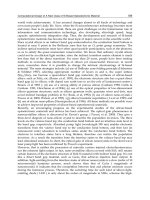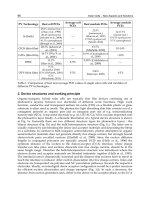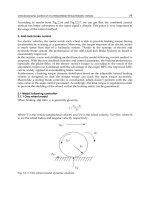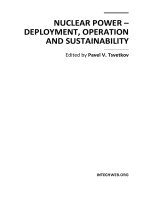Nuclear Power Deployment Operation and Sustainability Part 4 ppt
Bạn đang xem bản rút gọn của tài liệu. Xem và tải ngay bản đầy đủ của tài liệu tại đây (1.88 MB, 35 trang )
Nuclear Power – Deployment, Operation and Sustainability
94
Currently, Japan poses basic nuclear scenario where current LWR cycle transitions
completely to FR cycle and it is detailed as follows: 1) the period of LWR existence only, 2)
the transition period from LWR to FR, and 3) the equilibrium period of FR existence only.
Evaluation of equilibrium cycle is targeted to the third, ‘FR equilibrium period’. As the ‘FR
equilibrium period’, when only FR cycle and its fuel cycle exist, continues for long period of
time, plutonium composition in new fuels and spent fuels of FR, high-level radioactive
waste, and economics will converge to a certain equilibrium value and end up being simple
phase, that is ‘ the state of multiple equilibrium cycle’.
2.3 Performance evaluation tool both for equilibrium and transient nuclear fuel cycle
system
Regarding the evaluation methodology to seize the comprehensive characteristics of nuclear
energy (typically LWR cycle to FR cycle), the methodology is aimed at: 1) performing
comprehensive evaluation of nuclear energy business based on both transient period and
equilibrium period using the systematically structured data model of nuclear facilities; 2)
being a fundamental deliberation evaluation tool providing various information on R&D
and design study of nuclear energy system in the future. Evaluating dynamic nuclear
energy system in the transient period as well as FR cycle in equilibrium status, we employ
time-series evaluation method mainly dealing cash-flow or mass- flow regarding atomic
energy directly to reflect transition of target nuclear energy system.
From the view point of economic evaluation, a large-scale calculation system is required
because it is necessary to express cash-flow or mass-flow of every facility, such as nuclear
power reactor, fuel fabrication facility, reprocessing facility, waste disposal facility, etc. in
the life cycle consisting of construction, operation and decommissioning and to calculate the
amount of waste or cash-flow from nuclear system overall through adding up those cash-
flows or mass-flows.
With the knowledge of management engineering, this method was built based on the
concept of supply-chain management (SCM) for nuclear fuel cycle with the consideration of
business risk of nuclear fuel cycle which was carried out at the first stage of FS phase II.
Using the calculation tool employing time-series multi-dimensional evaluation method
basically developed in the final evaluation of FS phase II, we started development of the
system intensively and obtained sufficient functions to coordinate evaluation and review the
design of FaCT project. Thus the SCM code is at present developed as both performance
criteria evaluation tool and detailed transition period evaluation tool.
This method is network-flow type dynamic analysis model to simulate overall nuclear
energy business by forming nuclear facilities which makes up nuclear energy system.
Object-oriented design and analysis technique was used to enhance the system flexibility
and extendibility of the code. It covers almost all the facilities in Japan from the beginning of
the nuclear energy utilization and FR cycle equilibrium state in future. It can conduct
burnup calculation of nuclear fuel in nuclear power plants as well as decay calculation of
nuclear material in fuel cycle facilities including actinides, fission products, and other
nuclides although it only uses the ORIGEN-2 code with the libraries based on JENDL-3.3.
Although the evaluation started at the present in the figure, it should be started the
calculation at the beginning of the use of nuclear energy. With the capability described
above, it enables to evaluate both the amounts and compositions of materials/wastes.
Furthermore it can assess cost (economic efficiency) at all facilities in Japanese FR
deployment scenario (installed capacity) shown as Figure 2.
Characteristic Evaluation and Scenario Study on Fast Reactor Cycle in Japan
95
Con-
version
Nat. U
Enrich-
ment
Fabri-
cation
Reactor
Repro-
cessing
Waste
Processing
Waste
Disposal
Interim
Storage
NF Composition
S F C o oling T i m e
Transition Rate to Waste
Waste Generation
Storage Period
SF Cooling Time
Reprocessing Plant
Capacity
Enrichment
Maximum
Enrichment
Recovered U
SWU
Composition of Impurities
Constraints
Mass-flow
Waste Fabrication
Conditions
Buffer
Temperature
Receiving Condition
Recovered U
Recovered Pu
Output
Each facility
•
Availability factor
•
Nuclear material quantity and
composition
•
Amount of waste generation
•
Capital cost, Operation cost
Nuclear fleet
•
Sustainability Indices
•
Economics Indices
Material Flows
Constraints
Fig. 3. Nuclear supply chain and SCM code
Figure 3 shows the relationship between the facilities in nuclear fleet. For example, the
effects from the differences of breeding ratio of FR, reprocessing plant, and Am-Cm
recycling on characteristics from developmental targets influences the material flow from
reprocessing plant. With the object oriented design feature and mechanism that conveys
information and materials via the interface among highly independent facilities, it is easy to
place improvements on a facility by itself according to needs. Furthermore, the SCM code
enabled us to simulate nuclear fuel cycle overall in the process of procurement, dispose and
transportation of material from the upper to lower facilities without any major change with
facility data that indicates basic characteristics of nuclear facilities according to the provided
schemes and scenarios as the assumption of analyses by user in timely manners.
3. Characteristics evaluation of equilibrium FR cycle and scenario evaluation
In this section, evaluation on Japanese nuclear fleet in FaCT project is described mainly by
SCM code code. It covers almost all the facilities in Japan from the beginning of the nuclear
energy utilization and FR cycle equilibrium state in far future.
3.1 Characteristics evaluation of equilibrium FR cycle
The characteristics evaluations on FR cycle in equilibrium status related to the development
target of FaCT project, which are, economics, environment reservation, radioactive waste
management, uranium resource utilization efficiency, and proliferation resistance. The
recent results of the design studies of FR cycle reflected in the evaluations. In those
evaluations, single reactor and related fuel cycle were supposed to be evaluated.
3.1.1 Evaluation method of equilibrium cycle
The characteristics of system will be defined more clearly in its equilibrium state because FR
cycle is closed cycle which has limited mutual actions with outside. That means evaluation
Nuclear Power – Deployment, Operation and Sustainability
96
of equilibrium cycle is suitable method for conducting comparative evaluations on
candidate concepts having different characters with common manner. Furthermore, it
requires few preconditions aside from design result of FR cycle since mutual actions (mass
balance) with outside of FR cycle are small. Therefore, it will be relatively easy to apply
strict methods to evaluate and lessen the uncertainty which affect the characteristics of FR
cycle. In mass balance calculation, more sophisticated methods than those used in time-
series evaluation are applied and its calculation result is stable. The flexibility of SCM code
enabled us to treat FR cycle in equilibrium state and mixture of LWR cycle and FR cycle
transient state with unified manner in the same code. We are conducting the evaluations of
accumulative natural uranium demand, waste generation and economics for ‘the state of
multiple equilibrium cycle’.
3.1.2 Accumulative natural uranium demand
Although the analysis for cumulative natural uranium demand treats a transient
characteristic of nuclear fleet, natural uranium demand evaluation result is written here
because it is raised as one of the essential characteristics of FR cycle system. Figure 4 shows
Japan’s accumulative natural uranium demand of some scenarios, such as ‘LWR once
through’, ‘Pu recycling in LWR’ and ‘FR deployments’ in 2040, 2050 and 2060. In the cases of
LWR once through and Pu recycling in LWR, accumulative natural uranium demand in the
period of 2007 through 2120 will be about 1.5 million tons and 1.15 million tons,
respectively. In addition, if FRs with breeding ratio of 1.1 or 1.2 are deployed starting in
2050, all LWRs will be replaced to FRs completely around 2130, enabling accumulative
uranium demand to be saturated at about 0.8 million tons level which accounts for 5% of
conventional uranium resources (total about 16.7 million tons). Consequently, there will be
no need to import natural uranium from other countries. In the case of ‘LWR once through’
and ‘Pu recycling in LWR’, it will be required to procure large quantities of uranium even
after the late 21
st
century in which fears over depletion of uranium resource will be foreseen
worldwide. On the other hand, in ‘deployment of FR’ case, it will be unnecessary to import
uranium and will lead to an enhancing of energy security.
Cumulative Natural Uranium Demand
(Million tU)
0.0
0.5
1.0
1.5
2.0
2000 2020 2040 2060 2080 2100 2120 2140
LWR Once through Pu recycling in LWR
FR (BR1.2) deployment in 2050 FR (BR1.1) deployment in 2050
FR (BR1.1) deployment in 2040 FR (BR1.1) deployment in 2060
5% total conventional U resource
(0.84 million tonU)
Year
Fig. 4. Accumulative uranium demand in Japan
Characteristic Evaluation and Scenario Study on Fast Reactor Cycle in Japan
97
3.1.3 Waste generation
Nuclear energy supply chain is complicated and great deal of radioactive waste is handled
in it, thus sufficient safety measure and waste management should be established at the
nuclear facilities to prevent from influencing surrounding environment and residents. In
particular, we have to address the challenges to treat and dispose HLW generated in
reprocessing plant safely. Figure 5 indicates the amount of HLW unit of electricity generated
and usable years of final disposal site. In current LWR cycle, HLW, namely vitrified wastes
are produced with the amount of 30 canisters during the operation of LWR with 1GWe for a
year. While, in the future FR cycle case, it reduces the amount of vitrified waste by 20%
compared with the current LWR cycle because of high thermal efficiency of FR and
reduction of pyrogenic FP production. By reflecting foundational R&D result concerning FP
recycle in addition to the minor actinides recycle, it has possibility to achieve drastic
reduction of HLW and longer-use of disposal site. Figure 6 shows chronological changes of
potential harmfulness (relative values) of HLW (spent fuel (SF) and vitrified waste) in the
same amount of electricity generated for each case. After 1000 years later from being
discharged from nuclear reactor, in the vitrified waste produced from ‘Pu recycling in LWR’
case in which most of uranium and plutonium are recycled, potential harmfulness will be
reduced to 1/8 of that of spent fuel which is disposed directly in ‘LWR once through’ case.
Moreover, in FR cycle, minor actinides are also recycled in addition to uranium and
plutonium, enabling the potential harmfulness to be reduced to 1/30. Meanwhile, the
potential harmfulness of HLWs generated in each case are compared with the potential
harmfulness of natural uranium required to produce the same amount of electricity
generated as each case, which is indicated by the red dashed horizontal line in Figure 6. It
will take 100,000 years for the potential harmfulness of direct disposed spent fuel to reduce
to the same level with that from natural uranium, 10,000 years for the vitrified waste from
LWR cycle, and a couple of hundred years for the vitrified waste from FR cycle. Recycling
minor actinides in FR cycle enables us to reduce the potential harmfulness and
environmental burdens caused by HLW.
0
20
40
60
80
100
120
140
160
0
5
10
15
20
25
30
35
40
ガラス固化体発生量(本/GWy)
処分場利用可能年数(年)
Vitrified wastes generation per unit of electricity (n/GWy)
Geological repository lifetime (year)
LWR
(Current reprocessing
technology)
FBR
MA recycle
FBR
MA recycle
+partitioning of FP
FBR
MA recycle
FBR
MA recycle
+partitioning of FP
Vitrified wastes generation (n/GWy)
Geological repository lifetime (year)
- High thermal ef f iciency of FR
- Reduction of pyrogenic FP
production
- Improvement of FP content
rate by partitioning of
pyrogenic and platinoid FP,
and so on.
Fig. 5. HLW generation and usable years of final disposal site in Japan
Nuclear Power – Deployment, Operation and Sustainability
98
Fig. 6. Harmfulness of HLW (spent fuel and vitrified waste)
3.1.4 Economics
We are aiming at economics improvement due to a reduction of amount of material by
adoption of innovative technologies toward commercialization before 2050 since FR cycle
should be competitive in economy to become basic electric source in the future. Figure 7
shows estimation of the generation costs of current LWR, future LWR and Future FR
(breeding ratio of 1.1). The generation cost of future LWR will reduce to 60% of that of
current LWR by improvement of capacity factor and reduction in unit construction cost of
reactor. If FR (NOAK) provides superior performance as designed, it will be able to compete
with future LWR economically by the effect of high thermal efficiency and adoption of high
burn-up fuel, although the unit construction cost of reactor may be little higher. The total
cost consists of capital cost, operating cost and fuel cost accounting for about a third each.
As regard to FR, considering the effect of drop down of capacity factor and increase of the
unit fuel cycle cost posed by adoption of alternate technologies on the power generation
cost, the power generation cost will be almost the same level as that of current LWR.
However, it would appear that the FR cycle compete with the future LWR cycle
economically.
0
0.2
0.4
0.6
0.8
1
燃料費
運転費
資本費
現行軽水炉 将来軽水炉 FBR
発電原価( 相対値)
Fuel cost
Operating cost
Capital cost
Generation cost (relative value)
Current LWR
Future LWR
Future FR
Fig. 7. Comparison of the generation costs between LWR and FR (relative value)
Characteristic Evaluation and Scenario Study on Fast Reactor Cycle in Japan
99
3.1.5 Nuclear proliferation resistance
As nuclear materials are used as fuels in nuclear energy, we must sweep away the concerns
over nuclear proliferation. Japan has been applied comprehensive safeguards including
supplementary protocols and becomes an international model country. In addition, toward
a commercialization of FR cycle, it is making effort to lead the future nuclear non-
proliferation models by concept study for the process in which uranium will be constantly
accompanied by plutonium and minor actinides while developing state-of-art technologies
of safeguards and physical protections of nuclear materials. As one of the efforts, we are
studying for upgrading reactor cores with effective nuclear proliferation resistance and
identified the advantage to material barrier which is one of indexes for nuclear proliferation
resistance by evaluating isotope composition of plutonium in its spent blanket fuels. The
concepts of upgrading reactor cores with effective nuclear proliferation resistance are listed
as follows: the core without radial blanket fuels, the core with radial blanket fuels added by
plutonium and that added by minor actinides. Figure 8 shows the three core concepts.
Regarding the radial blanket fuels added by plutonium, the ratio of
240
Pu/Pu total in the
radial blanket spent fuels is more than 18% and it meets a criterion for reactor-grade
plutonium (
240
Pu/Pu total>18%) suggested by Dr. Pellaud. Thus, this design concept alters
the plutonium composition to the one without capability being nuclear weapon by adding
plutonium into radial blanket fuels, and become the one of measures to enhance the effect of
nuclear proliferation resistance.
Fig. 8. Three sample core concepts for enhancing the effect of nuclear proliferation resistance
(Taken from a figure of “JAEA R&D Review 2010”)
3.2 Japanese scenario evaluations with advanced analysis tool
In scenario evaluation, we mainly target at ‘the transition period from LWR to FR’, which is
the second item in the three periods indicated in section 3.1.1. LWRs, FRs and their nuclear
fuel cycles coexist in this transition period from LWR to FR. For this reason, in the
Nuclear Power – Deployment, Operation and Sustainability
100
evaluation of ‘the transition period from LWR to FR’, the results are characterized by the
complicated effects of various events and preconditions such as, the FR deployment pace,
introduction plan of reprocessing facilities, interim storages of spent fuels, recycle of
recovered uranium and so on. In the time–series scenario evaluation, we will optimize the
mass-balance among various types of reactors, cycle facilities and fuels and will focus
attention on the smooth transition to FR. Since we target at more complex mass-flow
comparing to the evaluation of equilibrium cycle, higher leveled and more sophisticated
methods must be applied in mass-balance calculation, waste generation, and cash-flow
evaluation, etc. In addition, the number of input items and calculation conditions increase
and this makes possible for the uncertainty about entire evaluation to be higher than that of
equilibrium cycle evaluation. We conduct the evaluations of the changes in nuclear material
and radioactive wastes at the same time including plutonium composition, the amount of
waste generation and economics on the transition state to the FR cycle.
The scenario analyses were performed to investigate the characteristics of current Japanese
nuclear fleet with LWR cycle to the future nuclear fleet with FR cycle. Based on the intensive
development of the SCM code to cover both equilibrium and transient status of nuclear fuel
cycle, economics, resources, radioactive wastes, and non-proliferation issues and the
complex of those issues have been surveyed with consideration of the recent technical
progress and events in Japanese society. The authors should begin with the alternation of
scenario in recent several years (after the establishment of “Framework for Nuclear Energy
Policy” in Japan). Although safety and reliability is raised as one of the important
development targets in FaCT project, the consideration of them is not directly reflected in
the analyses. Therefore, some important topics in the course of realizing the equilibrium FR
cycle state which bring uncertainties to Japanese nuclear fleet were discussed.
3.2.1 Basic Japanese scenario evaluations including recent change
The current image of Japanese nuclear energy capacity which is expressed in Framework for
Nuclear Energy Policy by Japan Atomic Energy Commission is shown in Figure 9.
FR
New LWRs
60 Yrs
lifetime
Nuclear Power
Plant Capacity(GWe)
Year
Exist
LWRs
40 Yrs
lifetime
Exi st
LWRs
60 Yrs
lifetime
Fig. 9. Nuclear power plant capacity image in the current Framework for Nuclear Energy
Policy (Original figure was AEC’s HP: Revised by the authors)
Characteristic Evaluation and Scenario Study on Fast Reactor Cycle in Japan
101
In Figure 9, important points of the nuclear power plant capacity are as follows:
In Japan, the nuclear capacity goal was changed from 58GWe,
The BR=1.1 was supposed for FR for future deployment,
The lifetimes of nuclear power plants were 40 to 60 years,
The reprocessing plants for FR spent fuels will be constructed independently from
those for LWR spent fuels.
However, more than five years have passed since the announcement of the current
Framework for Nuclear Energy Policy, the circumstances surrounding nuclear fuel cycle
including FR cycle also have been changed. The authors discuss several factors which will
affect the FR cycle long-term plan and strategy in this section.
First of all, the expectation for nuclear energy has been increased (at least before the accident
of Fukushima Daiichi Nuclear Power Station) because it is a just suitable energy to achieve
both to urge sustainable economic development and to reduce greenhouse gas emission in
the world. In Japan, national energy basic plan published in 2010 insisted that the nuclear
energy capacities up to 68GWe by 2030 mainly to meet both of sustainable economic growth
and greenhouse gas emission reduction. The increase of the expected nuclear capacity in
Japan will urge the breeding needs of FR and related fuel cycle in Japan. Regarding the
breeding ratio of FR, BR=1.1 is considered as the reference in the current Framework and
FaCT project, but FR with higher BR (ex.BR=1.2) which was described in former section is
also important in preparedness for the uncertainties of the fuel cycle operation and the
possibility of development toward global standard after the governmental evaluation of FS
Phase II. Besides, Japanese government, electricity utilities, and manufacturers are making
the concept of the next generation LWRs which has 80 years lifetime with the burnup of
more than 70GWd/tHM, etc. Additionally, the study on reprocessing facilities subsequent
to Rokkasho-Reprocessing Plant (RRP) has started. In the study, dual-purpose (LWR-SF and
FR-SF) reprocessing plants were proposed as well as independent single-purpose (for
exclusive use) reprocessing plants. Therefore, the authors tried to include those variations in
the analysis cases listed in Table 1.
Case Capacity
(GWe)
Core Fuel Breeding Ratio LWR
lifetime
Reprocesing
Plant mode
Conventional 58 (U, Pu, MA) oxide 1.1 to 1.03 60 Single Use
Recent (Ref.) 68 (U, Pu, MA) oxide 1.1 to 1.03 80 Dual Use
BR=1.2 68 (U, Pu, MA) oxide 1.2 to 1.03 80 Dual Use
60Yrs 68 (U, Pu, MA) oxide 1.1 to 1.03 60 Dual Use
Single Use 68 (U, Pu, MA) oxide 1,1 to 1.03 80 Singlel Use
Table 1. Analysis cases reflected basic nuclear energy policy change
In those analyses listed in Table 1, the influence of lifetime extension was largest on future
scenarios; change in breeding ratio and future nuclear power plant capacity had some
influence. The reprocessing plant mode had a relatively smaller influence, on the whole.
The authors would like to start an analysis treated the meaning of the breeding ratio in the
recent context of Japan. The result of FS showed that FR with breeder core of BR1.1 will be
enough to deploy FRs smoothly in 80 years for future Japan. The lifetime extension of next
generation LWRs to 80years helped reduce the breeding requirement of FRs in future Japan.
Nuclear Power – Deployment, Operation and Sustainability
102
Figure 10 shows the nuclear capacity in Japan for deployment of FR with BR=1.1 with the 80
years lifetime of LWR. The “Dual Use” means a reprocessing plant can be used both for
LWR-SF and FR-SF. On the contrary, “Single Use” means a reprocessing plant can be used
only for LWR-SF or FR-SF.
However, if some larger uncertainties are considered in scenario study, FRs with breeder
core of BR=1.2 contributes to offset the risk in Japanese nuclear energy system. Smaller
number of FRs with breeder core will be needed for future Japan as is shown in Figure 11.
Since cash-flow is the basis for all economics evaluation, Figure 12 shows the total cash-
flows of FR deployment scenarios with FR of BR=1.1 and BR=1.2 from Japanese nuclear fleet
from 2000 to 2200. It can be said that the decrease of total power generation cost was JPs
from JPY in BR=1.1 case from BR=1.2, the authors considered the economic merit was not
the critical reason to abandon higher breeding ratio, even if the relative low power
generation cost for BR=1.1 case acts as an incentive around the deployment stage of FR
cycle. Therefore, the room for breeding ratio adjustment corresponds to socio-environment
is an evidence of the inherent flexibility in core fuel with fast neutron.
Nuclear Power
Plant Capacity(GWe)
0
10
20
30
40
50
60
70
80
2000 2025 2050 2075 2100 2125 2150 2175 2200
LWR
High
Burnup
LWR
Next
Generation
LWR
L-MOX
Monju and FR Demo.
FR Breeding Core
FR Break-Even Core
Year
Fig. 10. The nuclear capacity for FR with BR=1.1 with the 80years lifetime of LWR
0
10
20
30
40
50
60
70
80
2000 2025 2050 2075 2100 2125 2150 2175 2200
LWR
High
Burnup
LWR
Next
Generation
LWR
L-MOX
Monju and FR Demo.
FR Breeding Core
FR Break-Even Core
Nuclear Power
Plant Capacity(GWe)
Year
Fig. 11. The nuclear capacity for FR with BR=1.2 with the 80years lifetime of LWR
Characteristic Evaluation and Scenario Study on Fast Reactor Cycle in Japan
103
As the readers can see several peaks and bottoms from the area chart in Figure 13, the
realistic cash-flows are different from simple averaged power generation costs (ex.
2.8JPY/kWh for BR=1.1 or 2.6 JPY/kWh for BR=1.03) although they became similar in far
future after 2200. The actual dynamic analysis result for electricity generation cost will not
usually accord with the simplified or averaged power generation cost of nuclear fleet. In
other words, the original cash-flow is the basis of the economic evaluation, it should not be
forgotten that simplified electricity generation cost result is basically studied from the
ground of cash-flow result in particularly in case of scenario (time-series) evaluation.
0
500
1,000
1,500
2,000
2,500
3,000
2000 2025 2050 2075 2100 2125 2150 2175 2200
0
500
1,000
1,500
2,000
2,500
3,000
2000 2025 2050 2075 2100 2125 2150 2175 2200
LWR Capital Cost
LWR Operation Cost
Natural Uranium(incl. Conversion,Enrichment)
LWR Fuel Fabrication
LWR Reprocessing
FBR Capital Cost
FBR Operation Cost
FBR Fuel Fabrication
FBR Reprocessing
SF Intermediate Storage
SF Transport,HLW Intermediate Storage,
Transport, Disposal
LLW Transport, Disposal
Industrial Waste Transport, Disposal
LWR Capital Cost
LWR Operation Cost
Natural Uranium(incl. Conversion,Enrichment)
LWR Fuel Fabrication
LWR Reprocessing
FBR Capital Cost
FBR Operation Cost
FBR Fuel Fabrication
FBR Reprocessing
SF Intermediate Storage
SF Transport,HLW Intermediate Storage,
Transport, Disposal
LLW Transport, Disposal
Industrial Waste Transport, Disposal
Year
Year
Total Cost [Billion JPY] Total Cost [Billion JPY]
Fig. 12. Total cash-flow of Japanese nuclear fleet for both (BR=1.1 and BR=1.2) cases
3.2.2 Radioactive waste management scenario evaluations
Another scenario study results showed that the effects of MA recycling on radioactive waste
management in FR cycle (reduction of HLWs generation from FR cycle or reduction of heat
emission from HLW in FR cycle to cut disposal area). The effect was described in 3.1.3 for
equilibrium state of FR cycle. It is caused partly by the nuclear materials in precedent LWR
cycle transferred from LWR cycle to FR cycle. The cases listed in Table 2 were analyzed by
SCM code on radioactive wastes (mainly HLW) generation.
Nuclear Power – Deployment, Operation and Sustainability
104
Case
Capacity
(GWe)
Core Fuel Breeding Ratio
Reprocesing Plant
mode
U-Pu, Single 68 (U, Pu) oxide 1.1 to 1.03 Single Use
U-Pu, Dual 68 (U, Pu) oxide 1.1 to 1.03 Dual Use
TRU, Single 68 (U, Pu, MA) oxide 1.1 to 1.03 Single Use
TRU, Dual 68 (U, Pu, MA) oxide 1.1 to 1.03 Dual Use
Table 2. Analysis cases with/without MA recycling
Since there was little difference in the results between the single use reprocessing plant case
and dual use plant case, the authors did not write the concrete case in the following part.
Figure 13 shows the radioactive wastes generation from Japanese nuclear fleet in reference
case based on the waste management evaluation by SCM code. There are several peaks in
the figure which correspond to the major facilities’ decommissioning such as LWR
reprocessing plants and nuclear power plants. Although the quantity of HLW is small, it
requires large scale facility for disposal and usually focused in disposal site finding issue.
Therefore, the influence on HLW from MA recycling is investigated in this section.
0
5,000
10,000
15,000
20,000
25,000
30,000
2000 2025 2050 2075 2100 2125 2150 2175 2200
Year
Trench Disposal
Concrete Pit Disposal
Shallow Land Disposal
Deep Geological Disposal
HLW
Radioactive Waste Generation
[m
3
/Year]
Fig. 13. Radioactive wastes generation from Japanese nuclear fleet
Figure 14 shows the calculated Japanese nuclear power plant capacities according to core
type in a typical case without MA recycling. FRs are deployed after 2050 just as same as the
reference case explained in 2.2.1. Since the completion of switchover to FR with (U, Pu)
oxide cores were delayed several years from the reference case, total transition period is 84
years from the analyses results. It is explained from the internal conversion ratio difference.
Nuclear Power
Plant Capacity(GWe)
0
10
20
30
40
50
60
70
80
2000 2025 2050 2075 2100 2125 2150 2175 2200
LWR
High
Burnup
LWR
Next
Generation
LWR
L-MOX
FR
Year
Fig. 14. FR deployment with core of BR=1.1 without MA recycling
Characteristic Evaluation and Scenario Study on Fast Reactor Cycle in Japan
105
When the total Japanese nuclear fleet is considered, MA recycling has the potential to reduce
the quantities of HLW from FR cycle system. Because of the difference in fuel cycle and
other discrepancies, it is difficult to compare directly the scenarios with or without MA
recycling. Comparing the quantities of HLW generation, Figure 15 was obtained. Though
there seems to be little difference (the difference is a kind of complex of causes) in HLW
generation from Figure 15, it is expected that the area needed for HLW disposal will be
reduced as a result of reduction in decay heat from HLW by MA recovery from raffinate in
reprocessing plants. Besides that, MA recycling leaves the possibility for further HLW
reduction combined with the introduction of high density FP packing in vitrified waste
technology. The reduction of HLW generation will be realistic if the high emission heat
nuclides are removed from HLW by the recovery of MAs and/or FPs as described in Figure
16. The difference of HLW generation after 2135 in Figure 17 is the combined effect of MA
recycling and high density FP packing in vitrified wastes although the fuel cycle schemes
are different because of the existence or non-existence of MA recycling.
0
50
100
150
200
250
300
350
400
450
2000 2025 2050 2075 2100 2125 2150 2175 2200
Year
HLW Generation [m
3
/Y ea r]
Without MA Recycling
With MA Recycling
Fig. 15. Comparison of HLW generation from nuclear fleets with and without MA recycling
0
50
100
150
200
250
300
350
400
450
2000 2025 2050 2075 2100 2125 2150 2175 2200
Year
HLW Gen eration [m
3
/Year]
Ref ere nce
High-Density FP Packing in Vitrified Wastes
Fig. 16. The effect of MA recycling combined with high-density FP packing in HLW
Nuclear Power – Deployment, Operation and Sustainability
106
3.2.3 Nuclear non-proliferation scenario evaluations
As for the scenario study related to non-proliferation, the measures to dope MAs in blanket
fuel to improve the non-proliferation characteristics of spent blanket fuel have some issue to
be resolved to supply sufficient amounts of MAs to all FRs and its fuel cycle system in
Japan. On the other hand, although the measure to add Pu in blanket may delay FR
deployment in future, it is feasible from both of the viewpoints of material supply and of
improving material barrier of spent blanket fuel. There are many ideas to enhance
proliferation resistance of FR cycle system.
Case
Core Fuel / Axial Blanket / Radial
Blanket
Reprocesing Plant
Depleted Uranium Blanket Fuel
(U, Pu, MA) oxide /
U Oxide / U oxide
Single Use
Radial Blanket Free Fuel
(U, Pu, MA) oxide /
U Oxide / -
Single/Dual Use
MOX Radial Blanket Fuel
(U, Pu, MA) oxide /
U Oxide / (U, Pu) oxide
Single/Dual Use
Radial Blanket Fuel with MA
Doping
(Minoa Actinide)
(U, Pu, MA) oxide /
U Oxide / (U, MA) oxide
Single/Dual Use
All MOX Blanket Fuel
(U, Pu, MA) oxide /
(U, Pu) oxide /(U, Pu) oxide
Single/Dual Use
All Blanket Fuels with MA Doping
(Minoa Actinide)
(U, Pu, MA) oxide /
(U, MA) oxide / (U, MA) oxide
Single/Dual Use
Table 3. Analysis cases for non-proliferation improvement core
The analysis cases listed in Table 3 reflect the authors’ concern on the measures to apply to
the Pu in blanket SF of FR. In Case-1, called the “Radial Blanket Free Core” concept, the
radial blanket is replaced by a steel reflector, In Case-2, the radial blanket is fabricated with
Pu in low isotope enrichment so that the plutonium produced in the radial blanket will have
a low-fissile ratio. In Case-3 the radial blanket fuel is doped MA, which reduces the
attractiveness because of the heat generation from Pu-238. The maximum MA ratio of new
core fuel was assumed to be 5wt% which was almost recovered from spent LWR fuels
although the MA ratio of new core fuel in the equilibrium state FR cycle. In Case-4, the
radial blanket is fabricated with Pu in low isotope enrichment so that the plutonium
produced in the radial blanket will have a low-fissile ratio. In Case-5 the radial blanket fuel
is doped MA, which reduces the attractiveness because of the heat generation from Pu-238.
The maximum MA ratio of new core fuel was assumed to be 5wt% which was almost
recovered from spent LWR fuels although the MA ratio of new core fuel of FR in the
equilibrium state is considered as about one per cent.
The nuclear power plant capacities of all MOX blanket fuel case and all blanket fuel with
MA doping case are shown in Figure 17 and figure 18, respectively. No severe influence on
smooth introduction of FRs was seen from the analyses. The authors tried to confirm the
effect of Pu addition to blanket fuel through the analyses with SCM code. Dr. Pellaud
defined the plutonium including more than 18% of Pu-240 as “reactor grade” (RG-Pu) as it
was explained in 3.1.6. Plutonium in LWR SF meets this RG-Pu condition; it has been used
Characteristic Evaluation and Scenario Study on Fast Reactor Cycle in Japan
107
globally in commercial manner under the appropriate nuclear material control and
management. If the idea that proliferation resistance target of future nuclear energy system
should fulfil a kind of “Pareto criterion” in material attractiveness is true, FR cycle system
which uses RG-Pu achieves the target. The transition of Pu240/Pu in blanket SF in “All
MOX blanket core” case is shown in Figure 19. The Pu240/Pu keeps more or equal than 18%
in general during the lifetime of the reactor though the option somewhat sacrifices the speed
of FR deployment.
Nuclear Power
Plant Capacity(GWe)
0
10
20
30
40
50
60
70
80
2000 2025 2050 2075 2100 2125 2150 2175 2200
LWR
High
Burnup
LWR
Next
Generation
LWR
L-MOX
FR
Year
Fig. 17. FR deployment scenario for all MOX blanket case
Nuclear Power
Plant Capacity(GWe)
0
10
20
30
40
50
60
70
80
2000 2025 2050 2075 2100 2125 2150 2175 2200
LWR
High
Burnup
LWR
Next
Generation
LWR
L-MOX
FR
Year
Fig. 18. FR deployment scenario for in all blankets with MA doping case
Pu isotope content in blanket SF during the transition period from LWR to FR in all MA
doping blanket fuel case is shown in Figure 20. As for the period when FRs with radial
blanket are installed (before 2090), it looks difficult to meet Kessler’s criteria because of the
shortage of MAs supply to dope blanket fuels. Regarding heat emission from radial blanket
assemblies, it reached around the boundary condition (2.6kW/Assembly) for the design
study in FaCT project. Meanwhile, FRs without radial blanket increase after 2090; although
the quantity of MAs are enough for the criteria, it may need additional measure for high
decay heat emission from radial blanket assemblies because of the recovered MAs with high
Nuclear Power – Deployment, Operation and Sustainability
108
decay heat in FR cycle. Though only an example scenario is provided here, it can be said
that the measure to improve proliferation resistance of blanket SF by MA doping should be
careful for both proliferation resistance requirements and realistic constraints of fuel cycle
operation at the same time.
0%
2%
4%
6%
8%
10%
0%
6%
12%
18%
24%
30%
2000 2025 2050 2075 2100 2125 2150
Pu240/Pu of Blanket SF
Pu Content of Blanket NF
Pu240/Pu
Year
Pu Enrichment
Fig. 19. Pu 240/Pu in blanket SF of all MOX blanket fuel case
0%
1%
2%
3%
4%
5%
6%
7%
0%
2%
4%
6%
8%
10%
12%
14%
2000 2025 2050 2075 2100 2125 2150
Pu238/Pu of Radial Blanket SF
MA Content of Radial Blanket NF
Pu238/Pu
MA Content
Year
Year
Decay Heat (kW/Assembly)
0.0
0.5
1.0
1.5
2.0
2.5
3.0
3.5
2000 2025 2050 2075 2100 2125 2150
Outer Core + Axial Blanket
Inner Core + Axial Blanket
Radial Blanket
Fig. 20. Pu 238/Pu of blanket SF and decay heat emission from assemblies in all blanket
fuels with MA doping case
In general, the measure except for “all blanket with MA” case in this scenario study to
improve proliferation resistance of blanket spent fuel in FR can achieve their purposes
unless they are reviewed from broader feasibility including R&D difficulties, adverse effect
on economics, and other logistics issues, etc. Accordingly, it should be paid attention to the
by-effects described above in case such measures are applied as a practical manner in future.
3.2.4 Advanced topics and latest situation of Japanese nuclear energy
The authors will explain the more realistic supposition in the scenario analyses with the Pu
possession by utility companies. Furthermore, a scenario study for the influence of accident
in Fukushima Daiichi occurred after a gigantic earthquake hit several prefectures in eastern
part of Japan in March, 2011.
Characteristic Evaluation and Scenario Study on Fast Reactor Cycle in Japan
109
Conventional scenario analyses usually consider the Japanese nuclear power plants as one
block; therefore, they ignore both the property right of nuclear material and/or constrains
based on the matter of contracts between companies in general. Regarding the detailed
analysis dealing Pu recycling in LWR with full MOX core at Ohma by J-Power, the analysis
tool can reflect plutonium transfer contracts between J-power and 7 electric utilities
(Tohoku, Tokyo, Chubu, Hokuriku, Chugoku, Shikoku, and Kyushu) for the initial loading
core. If the future Pu balance was considered from worm’s-eye view, such kinds of transfers
should be counted. An example of rough estimation of Pu transfers during “Pu recycling in
LWR period” in Japan between electricity utilities by SCM code was shown in Figure 21.
Besides the Pu demands in Figure 22, other Pu is needed for FR deployment and running
stock for operation from the discrepancy of recovered Pu and Pu demand for Pu recycling in
LWR. J-power may have to gather Pu from other electricity utilities for Pu recycling in
Ohma plant.
0
50
100
21.5
0
50
100
4.1
0
50
100
69.5
0
50
100
3.9
0
50
100
43.4
0
50
100
4.9
0
50
100
22.5
0
50
100
1.5
0
50
100
3.7
0
50
100
82.8
0
50
100
0.6
Hokkaido Electric Power
Toh o k u El ec t ri c P ower
Tok y o El e c t ri c P owe r
Chubu Electric Power
Kansai Electric Power
Hokuriku Electric Power
Chugoku Electric Power
Shikoku Electric Power
Kyusyu Electric Power
Japan Atomic Power
J-POWER
Recovered Pu
0
50
100
37.4
0
50
100
3.5
0
50
100
2.0
0
50
100
42.0
0
50
100
3.7
0
50
100
2.9
0
50
100
35.8
0
50
100
14.7
0
50
100
3.9
0
50
100
28.7
0
50
100
51.8
Transfer for Hokuriku Electric Power
Transfer for J- POWER
Dotted line shows Pu transfer
between electricity utilities
0
0.5
1
1.5
2
2.5
0.0
1.6
0.2
0.1
0.2
0.2
Japan Atomic Power
Cyugoku Electric Power
Kansai Electric Power
Cyubu Electric Power
To ky o Elec tr ic P ow e r
Tohoku Electric Power
0
10
20
30
40
50
60
1.1
22.5
0.9
12.0
6.5
0.6
8.2
Kyusyu Electric Power
Shikoku Electric Power
Cyugoku Electric Power
Kansai Electric Power
Cyubu Electric Power
To ky o Elec tr ic P ow er
Tohoku Electric Power
Pu Demand
Fig. 21. Example of Pu transfer estimation during “plutonium recycling in LWR” period in
Japan
Nuclear Power – Deployment, Operation and Sustainability
110
A larger earthquake ever recorded in Japanese history hit northern eastern part of Japan on
March 11, 2011, the record-breaking tsunami occurred subsequent to the earthquake caused
severe accident of Fukushima Daiichi Nuclear Power Station. Concerning the influence of
the accident on Japanese nuclear policies, it is too early to say something definitive because
the accident has not finalized yet and the governmental argument on future energy policies
has not started. Presently, the authors can suggest the role and flexibility of FR cycle
according to the series of analyses by SCM code with the following assumptions:
The nuclear power plants involved in Fukushima Daiichi accident (Fukushima-1 No.1
to NO. 4) will not restart,
Though new nuclear power plants will not be constructed in new locations, the existing
nuclear power plants other than listed above will be replaced by new nuclear power
plants.
The breeding requirement for FR cycle system will be reduced under the assumption of both
withdrawals from several nuclear power plants and deployment of next generation LWRs
with longer plant lifetime. The result also indicated that FR cycle will be FR with break-even
core from the beginning of installation without rapid breeding needs. It will curb fuel cycle
cost through the reduction of mass-flow by the usage of high burnup fuel. The flexibility of
breeding capability in FR leads us to adapt both higher nuclear capacity and lower nuclear
capacity to some extent by giving weight to economics or breeding in the coexistence of
LWR and FR nuclear fleet in transient state.
4. Conclusion
The authors tried to provide overall path to nuclear energy system with FR and related fuel
cycle facilities firstly. Along with to the R&D effort to improve economic competitiveness,
safety and reliability, and several ideas for future uncertainties the fissile material breeding
ability of FR cycle system and the potential of FR core with fast neutron to burn broader
isotopes, FR is major option for electricity supply for future Japan.
Secondly, the recent achievement in SCM code as the system dynamic analysis tool in FaCT
project. Because of the sufficient flexibility of the newly developed analysis code based on
object-oriented design, it can meet both “single plant characteristic evaluation” and
“Japanese whole nuclear fleet scenario study until 22nd century”. The code will be used as
an infrastructure of future nuclear energy system in Japan.
In addition to the fact that a nuclear energy system development usually needs a long lead-
time for decades, it was important that the development of the current LWR cycle and R&Ds
may have an influence on successive nuclear energy system including FR cycle through the
supply chain of nuclear energy system. Nuclear energy utilization and development become
a matter of argument in reaction to the occurrence of Fukushima Daiichi’s accident, it
should be keep in mind that today’s decision on the directions of nuclear energy R&D under
influence of the fresh memory of accident may make a difference in far future as well as that
in immediate future.
5. Acknowledgment
The authors would like to express their deep gratitude to both Mr. Heta and Mr. Yasumatsu
of NESI Inc. for their contribution for the various works. The authors also would like to
express admiration for Mr. Ishii and other members of Mizuho Information and Research
for their high performance in the development of the analysis code.
Characteristic Evaluation and Scenario Study on Fast Reactor Cycle in Japan
111
6. References
Grover R. B. and Chandra S. (2004). A Strategy for Growth of Electrical Energy in India,
DAE Report No.10
Japan Atomic Energy Agency. (2011), JAEA R&D Review 2010, What Core Design Prevents
Nuclear Proliferation? –Commercial FBR Core Study Focusing on a Material
Barrier-, 12, (CD-ROM)
Japan Atomic Energy Agency/Japan Atomic Power Company. (2009), Fast Reactor Cycle
Technology Development Project (FaCT Project) – Phase I (Interim Report) –, JAEA-
Evaluation-2009-003, (May 2009) (in Japanese)
Japan Atomic Energy Commision. (2005), Framework for Nuclear Energy Policy, (October
2005)
Japan Atomic Energy Commision. (2010), Appropriateness of the „Plutonium Utilization
Plans (FY2010)“ Announced by Electric Utilities and the IAEA, (March 2010), AEC
HP , Apr 12, 2011, Available from:
<
Kawashima, K. et al. (2010). Fast reactor Core Design Considerations from Proliferation
Resistance Aspects, Proceedings of FR09, Kyoto, Japan, December 7-11, 2009
Ministry of Economy, Trade and Industry. (2010), Basic Energy Plan (June 2010), pp. 27, 31,
32 (in Japanese)
Ministry of Economy, Trade and Industry. (2010), FY2010 Electric Power Supply Plan
(March 2010) (in Japanese)
Ministry of Education, Trade and Technology. (2010),Seinoumokuhyou no tasseido hyouka
(1)-(3), MEXT HP, April 12, 2011, Available from:
/>afieldfile/2010/12/28/1300643_1.pdf,
/>afieldfile/2010/12/28/1300643_2.pdf,
/>afieldfile/2010/12/28/1300643_3.pdf
Nuclear energy subcommittee of Electricity Industry Committee of Advisory Committee for
Natural Resources and Energyin Ministry of Economy, Trade and Industry. (2006),
Japan’s Nuclear Energy National Plan (August 2006), pp. 63 (in Japanese)
OECD/IEA. (2008), Energy Technology Perspectives 2008
OECD/IEA. (2009). World Energy Outlook 2009
OECD/IEA. (2010). Energy Technology Perspectives 2010
OECD/NEA & IAEA. (2010). Uranium 2009: Resources, Production and Demand
Ohki, S. et al., (2008). FBR core concepts in the FaCT Project in Japan, Proceedings of Physor
‘08, Interlaken, Switzerland, September 14-19, 2008
Sagayama Y. (2010), Long-term Nuclear Energy Development Scenario for Sustainable
Energy Supply, Electrical Review, Vol.556 (December 2010) (in Japanese)
The advisory committee for Natural Resources and Energy’s subcommittee to study costs
and other issues, The report of the Advisory Committee for Natural Resources and
Energy’s subcommittee to study costs and other issues, Japan. (2004)(in Japanese).
Nuclear Power – Deployment, Operation and Sustainability
112
Xu M. (2005). Status and Prospects of Sustainable Nuclear Power Supply in China, GLOBAL
2005, Tsukuba, Japan, Oct. 9-13 2005
5
Nuclear Proliferation
Michael Zentner
Pacific Northwest National Laboratory
United States of America
1. Introduction
Early nuclear energy system designs grew out of programs to develop nuclear weapons,
and accordingly these systems were optimized to produce weapons usable material. As the
nuclear industry matured and the use of nuclear power spread, safety, cost, environmental
impact and waste management considerations shaped nuclear energy system designs that
were deployed for the purpose of producing electricity. A multi-faceted international
nonproliferation regime comprised of treaty commitments and obligations, verification
mechanisms, export controls, and diplomatic strategies intended to dissuade States from
proliferating has grown (Figure 1). Likewise, measures to prevent theft of nuclear materials
by subnational groups have been implemented at both the national and international levels.
There has been continuing interest in developing nuclear technologies that would permit the
peaceful use of nuclear power without an associated proliferation of nuclear weapons
capability. The term “proliferation resistant” was coined to describe technologies that are
not suitable for the production of weapons usable material.
Despite this interest in “proliferation resistant technologies,” the reality remains that a truly
proliferation-proof nuclear energy system has yet to be discovered. A fuller understanding
of the nature of nuclear proliferation would suggest that motivation, underlying political-
military ambitions, in some cases domestic political imperatives, are key drivers for
proliferation or for decisions not to pursue nuclear weapons development. There is no
technological “silver bullet” that will solve the proliferation challenge. Even for technologies
that are said to be more difficult to misuse for proliferation purposes, one must recognize
that the international transfer of such technology can impart to the recipient technical
capabilities and know-how that can be put to use in facilities that could be used to support a
nuclear weapons program.
A more productive course of action would be to consider how a particular technology or
facility design might lend itself to more effective and efficient forms of international
verification by the International Atomic Energy Agency. Beginning early in the 1950s,
international safeguards agreements and principles were put in place to make certain that as
the use of nuclear power spread it would be used for peaceful purposes only, and if a State
were to misuse these technologies it would be detectable so that the international
community could take timely action. The more difficult and detectable it was to use a
system to make nuclear weapons usable material, the better.
As discussed below, the notion of “proliferation resistance” in this context is more relative,
that is, how one system might compare to another. Results of proliferation resistance studies
Nuclear Power – Deployment, Operation and Sustainability
114
should not be construed as implying that a particular system is proliferation-proof, nor that
features claimed to make a system more proliferation resistant provide a rationale for
relaxing: 1) international safeguards for such systems; 2) controls on the export of such
systems and related technologies; or 3) the nonproliferation credentials and commitments of
the recipient of such technology transfers.
Fig. 1. International safeguards agreements
Nuclear energy system designers and engineers must understand not only how to design
and build their systems to make them safe and secure, but also easy to safeguard. In this
chapter, we will show how proliferation resistance has been studied, what can be learned
from these studies, and how the results can used in the international community. As already
stated, the problem of nuclear proliferation is multi-faceted, with a long and complicated
history, and for purposes of this chapter we will focus only on the concept of proliferation
resistance.
2. Proliferation resistance
The generally accepted definition for proliferation resistance is:
“… that characteristic of a nuclear energy system that impedes the diversion or undeclared
production of nuclear material or misuse of technology by States in order to acquire nuclear weapons
or other nuclear explosive devices. The degree of proliferation resistance results from a combination of,
inter alia; technical design features, operational modalities, institutional arrangements and
safeguards measures. Intrinsic proliferation resistance features are those features that result from the
technical design of nuclear energy systems, including those that facilitate the implementation of
extrinsic measures. Extrinsic proliferation resistance measures are those measures that result from
States’ decisions and undertakings related to nuclear energy systems.” (IAEA-STR-332, 2002)
Nuclear Proliferation
115
This definition makes clear that proliferation resistance should be considered a function of
the intrinsic technical features (facility design and operation) and extrinsic properties
(implementation of international agreements and safeguards) of a nuclear energy system.
The degree of effectiveness of these properties is used to determine a nuclear energy
system’s proliferation resistance.
Studies of nuclear proliferation can be broadly separated into two distinct categories, as
follows:
State-level proliferation studies (e.g., Meyer 1984; Singh & Way 2004; Li et al. 2009, etc.)
examine the implications and consequences of State motivations, resources (technical,
human, and financial), geostrategic or regional rivalries, and international agreements.
Using this information, analysts assess the likelihood that a State will proliferate or
attempt to do so.
Technical proliferation studies address elements of Nuclear Energy Systems (NES),
focusing on their possible contributions to a nuclear weapons program. Technical
studies can range from evaluating an individual facility or unit to examining all
elements of a fuel cycle.
This chapter focuses on technical proliferation resistance studies, which can be used to:
evaluate characteristics of proposed nuclear energy systems that are intended to
impede the diversion or undeclared production of nuclear material or the misuse of
technology,
evaluate the vulnerability of proposed NES design and operational features from a
proliferation resistance point of view,
evaluate the applicability and effectiveness of international safeguards measures,
provide a basis for improving both facility intrinsic features (design options) and
extrinsic measures (safeguards) to achieve an appropriate balance, and
communicate proliferation resistance strengths and weaknesses of the NES to decision
makers in a transparent, understandable and meaningful way. (Zentner, et al., 2009)
3. Proliferation risk
Although the terms “proliferation resistance” and “proliferation risk” are sometimes used
interchangeably, they are not synonymous. Technically, risk can be defined (Kaplan &
Garrick, 1981) in terms of a risk “triplet”: 1) What can go wrong? 2) How likely is it? 3) What
are the consequences? For proliferation risk, technical proliferation resistance studies answer
the first and the third questions, but answering the second—the likelihood of the deliberate
act of proliferation—is a difficult calculation most suited to State level proliferation studies
as described above.
Accordingly, proliferation resistance should be considered a component of proliferation
risk, and proliferation resistance studies may be useful to identify means of addressing
elements of that risk. The concept of proliferation risk includes much broader political
considerations than proliferation resistance, and will not be further addressed here.
4. Physical protection
It is important to understand the difference between the concepts of Proliferation Resistance
and Physical Protection. Physical protection is defined as “that characteristic of an NES that
impedes the theft of materials suitable for nuclear explosives or radiation dispersal devices
Nuclear Power – Deployment, Operation and Sustainability
116
(RDDs) and the sabotage of facilities and transportation by sub-national entities and other
non-Host State adversaries.
The objective of a physical protection system is to minimize the susceptibility to and
opportunity for unauthorized removal of nuclear material in use, storage or transport and of
sabotage of nuclear material and nuclear facilities. The effectiveness of the system is
demonstrated by its capability to prevent the successful execution of a malicious act and to
prevent and/or mitigate radiological consequences thereof.
Physical protection concerns are not unique to the nuclear industry. Although what is to be
protected; consequences of a successful attack; and approaches for detecting, delaying, and
responding to an attack may differ, the same basic principles are applied to protect any
important facility against sabotage or theft, whether it is an NES, an oil refinery, a
communications center, or a military site (Bari, 2009). Accordingly Physical Protection will
not be further addressed in this chapter.
5. Studying proliferation resistance
A number of distinct procedures for the study of proliferation resistance exist. Four
representative methodologies (TOPS
1
, INPRO
2
, SAPRA
3
, and GEN IV PR&PP WG
4
) are
described below. All use the standard definition of proliferation resistance, “… that
characteristic of a nuclear energy system that impedes the diversion or undeclared production of
nuclear material or misuse of technology by States in order to acquire nuclear weapons or other
nuclear explosive device…”, but take distinctly different approaches.
They can be broadly separated into two classes: multi-attribute utility analyses (MAUA)
and pathway analyses. In the first class (TOPS, INPRO, and SAPRA) a set of attributes (i.e.,
material and technical barriers to proliferation) are identified and relevant values are
established for measuring the relevant importance or effectiveness of each barrier against a
particular proliferation threat. In the second class (GEN IV PR&PP WG) possible
proliferation pathways are postulated involving the diversion of weapons usable material or
misuse of technology to produce such material. For each pathway, acquisition scenarios are
identified and analyzed, and the resulting outcomes are compared using specified sets of
proliferation resistance measures.
5.1 Technological Opportunities to Increase the Proliferation Resistance of Global
Civilian Nuclear Power Systems (TOPS)
The TOPS Task Force
5
was established in 1999 to “identify near and long-term technical
opportunities to increase the proliferation resistance of global civilian nuclear power
systems and to recommend specific areas of research that should be pursued to further these
goals” (TOPS, 2001). After reviewing several proposed approaches, a MAUA methodology
was developed that identifies a set of material and technical attributes considered barriers to
proliferation, with relevant importance values. Material barriers are properties that affect the
1
TOPS: Technological Opportunities to Increase the Proliferation Resistance of Global Civilian Nuclear Power
Systems
2
INPRO: International Project on Innovative Nuclear Reactors and Fuel Cycles (IAEA)
3
SAPRA: Simplified Approach for Proliferation Resistance Assessment of Nuclear Systems
4
GEN IV PR&PP WG: Generation IV Proliferation Resistance and Physical Protection Working Group
5
Created by the U.S. Department of Energy (DOE) Office of Nuclear Energy, Science, and Technology
and DOE’s Nuclear Energy Research Advisory Committee (NERAC)
Nuclear Proliferation
117
desirability or attractiveness of the material as an explosive. Technical barriers are those
aspects that make it difficult to gain access to materials and/or to use or misuse facilities to
obtain weapons-usable materials (Table 1).
Table 1. Comparison of TOPS and SAPRA barriers (Greneche et al., 2007)
Diversion Transport Transform
Weapon
fabricate
Critical Mass 1
Isotopic Enrichment 2
Spontaneous Neutron
Generation
Heat Generation Rate
Radiation
3
Material
Facility unattractiveness
SAPRA
TOPS
Note
Isotopic
Dangerousness (other than
irradiation)
Chemical
Barrier Descriptions
Time
Technical difficulty
Radiological (other than the
material)
Mass and bulk
Physical form
Detectability
Collusion level
Construction detectability
Signature of installation
Technical
Safeguards
Access/control/security
Facility accessibility
Available mass
Diversion detectability
Skill, expertise, knowledge
3 - In SAPRA, this barrier is implicitly included in other technical barriers linked to the
diversion phase, in particular the "technical difficulty" and accessibility" barriers
Notes:
Barriers Considered in each method
Location/distance (for transport
phase)
Extrinsic
1 - in SAPRA, this barrier is implicitly included in "Mass and Bulk" barrier
2- Isotopic barrier pla
y
s a role onl
y
when enrichment is inescapable to obtained direct
weapons usable material
Nuclear Power – Deployment, Operation and Sustainability
118
Examples of material barriers used in the original TOPS procedure included material
isotopic, radiological, and chemical properties, in addition to mass or bulk. Technical
barriers included attractiveness of the facility to a potential weapons program, difficulty of
facility access, detectability of proliferator actions, and necessary skills and time needed for
the proliferator’s actions.
As the use of the TOPS methodology has matured, a variety of approaches has been
developed to determine barrier values. For example, in one proliferation resistance study
using the TOPS approach (Skutnik et al., 2009), barrier values were developed using a
“fuzzy logic” based attributed analysis approach. This technique was intended to overcome
the challenges of subjectivity inherent in development of the barrier values. The resulting
model was tested by evaluating several reprocessing technologies, and the results were
found to generally agree with more structured PR studies.
The TOPS approach forms the basis for a number of advanced assessment methodologies,
two of which (INPRO and SAPRA) are described in more detail below.
5.2 Simplified Approach for Proliferation Resistance Assessment of Nuclear Systems
(SAPRA)
In 2002, a French nuclear industry working group was formed to select and develop a
methodology for assessing the proliferation resistance of nuclear energy systems. The result
was a methodology called the Simplified Approach for Proliferation Resistance Assessment of
Nuclear Systems (SAPRA). SAPRA (Greneche et al., 2007) is an evolutionary approach based
on the TOPS methodology, with a number of modifications, additions, and improvements.
Table 1 compares the two approaches.
SAPRA separates proliferation into four phases: diversion, transport, transformation, and
nuclear weapon fabrication. At each phase, intrinsic and extrinsic barriers to proliferation
are identified and scored based on the perceived robustness of the barrier. SAPRA
addressed the complete fuel cycle. A panel of experts was assembled to determine the
values to be assigned to each of the barriers. The values were then added together to give an
aggregate “Proliferation Resistance Index.” Using these results the strengths and
weaknesses of the various nuclear energy systems studied were identified. SAPRA is unique
among most proliferation resistance assessment approaches in that it explicitly includes
theft by a State as a possible proliferation threat.
5.3 Guidance for the Application of an Assessment Methodology for Innovative
Nuclear Energy Systems – Proliferation Resistance (INPRO)
Beginning in 2002, the IAEA’s International Project on Innovative Nuclear Reactors and Fuel
Cycles (INPRO) developed a proliferation resistance assessment methodology that is
primarily based on a multi-attribute utility analysis approach. The INPRO proliferation
resistance approach identifies one Basic Principle of Proliferation Resistance with five User
Requirements for meeting this Principle, along with seventeen indicators with specific criteria
and acceptance limits (IAEA, 2007).
The Proliferation Resistance Basic Principle is: “Proliferation resistance intrinsic features and
extrinsic measures shall be implemented throughout the full life cycle for an INS to help ensure that
INSs will continue to be an unattractive means to acquire fissile material for a nuclear weapons
program. Both intrinsic features and extrinsic measures are essential, and neither shall be considered
sufficient by itself.”









